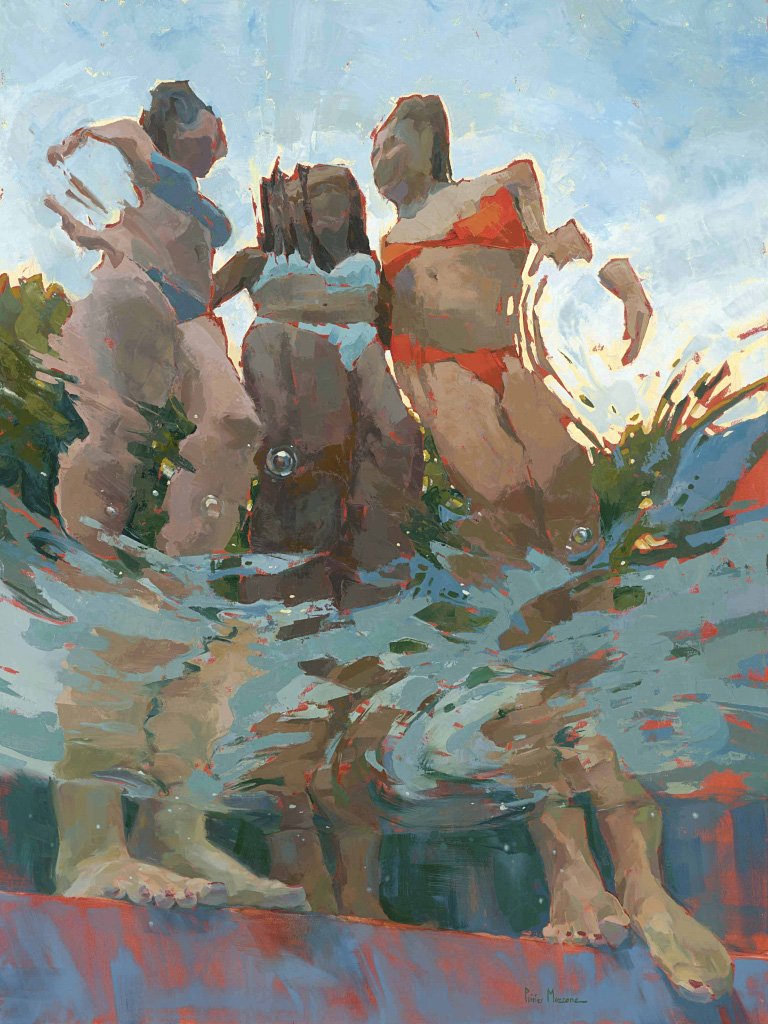'Fractured Light': An Interview With Artist Michele Poirier Mozzone
In the realm where fashion, beauty, and art converge, there are artists who can capture the essence of human experiences and translate them into mesmerizing visual narratives. Among these talented individuals is Massachusetts-based painter Michele Poirier Mozzone, whose works embody the ethereal effects of water and sunlight on the human figure. Through her evocative brushstrokes and masterful use of color, Poirier Mozzone invites viewers to immerse themselves in a world where moments are frozen in time, vibrant hues dance across the canvas, and the human form is celebrated as a conduit for universal emotions.
Poirier Mozzone's contemporary figurative paintings in the Fractured Light series evoke a profound sense of connection and nostalgia. They transport viewers to a realm where time stands still, where the human form becomes a vessel for emotions and memories. Each stroke of her brush and each choice of color speaks volumes, creating an interplay of light and shadow that breathes life into her subjects. Through her art, Poirier Mozzone invites us to contemplate our own experiences, to delve into the depths of our emotions, and to appreciate the beauty that lies within the everyday.
Stepping into the vibrant world of Michele Poirier Mozzone's art, we sat down with the painter to unravel the inspirations, techniques, and profound emotions that breathe life into her captivating Fractured Light series.
Can you explain the significance of capturing the human figure in sunlight-drenched water in your artwork? What themes or emotions do you aim to convey through this subject matter?
The paintings are not about anyone in particular, but about capturing a common experience, memory or idea. Most of us have experienced the sound of bubbles rushing past our ears, the broken ribbons of sunlight, bizarre reflections, fascinating distortions and the weightless, slow dance of movement below the water’s surface. Water brings change, gives life and can take life away. Bubbles are ideas and intentions that rise to the open air while each figure is interpreted as reacting to a moment in this surreal, wet world.
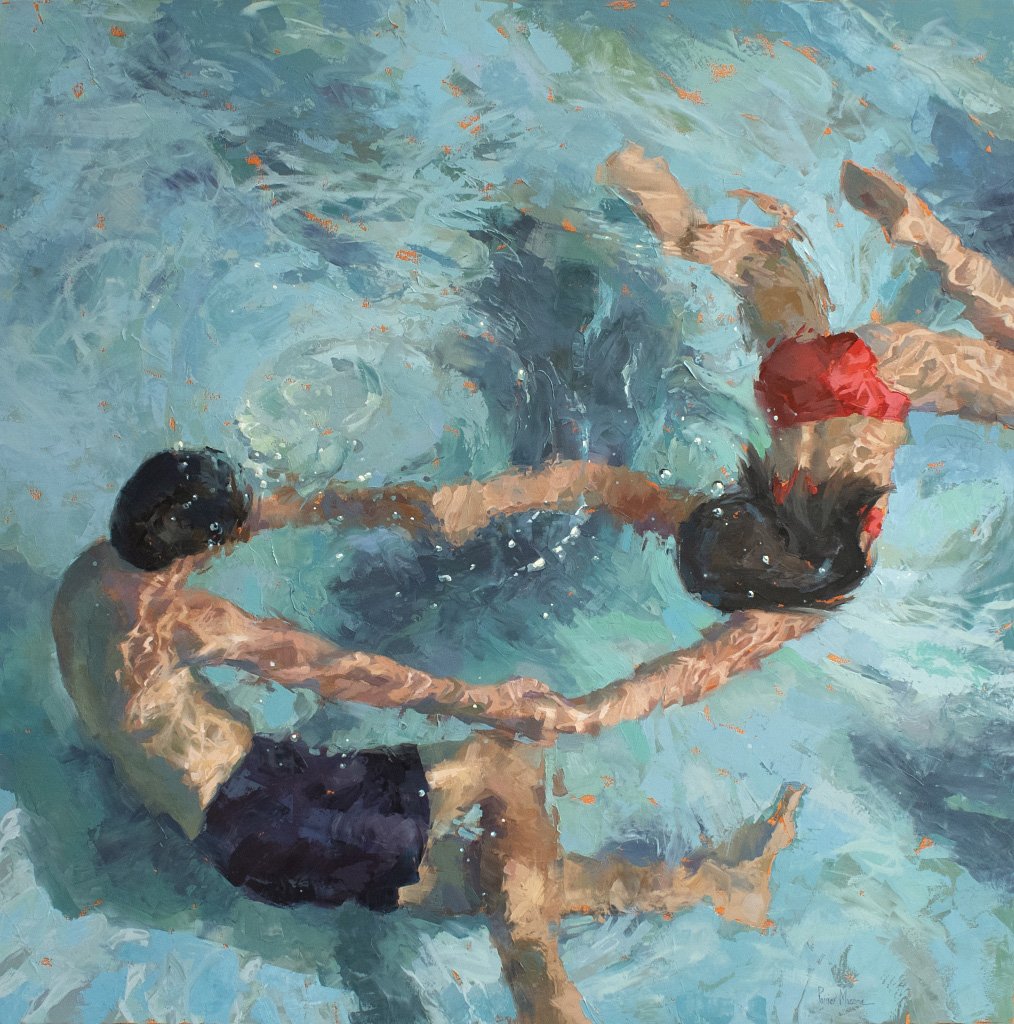

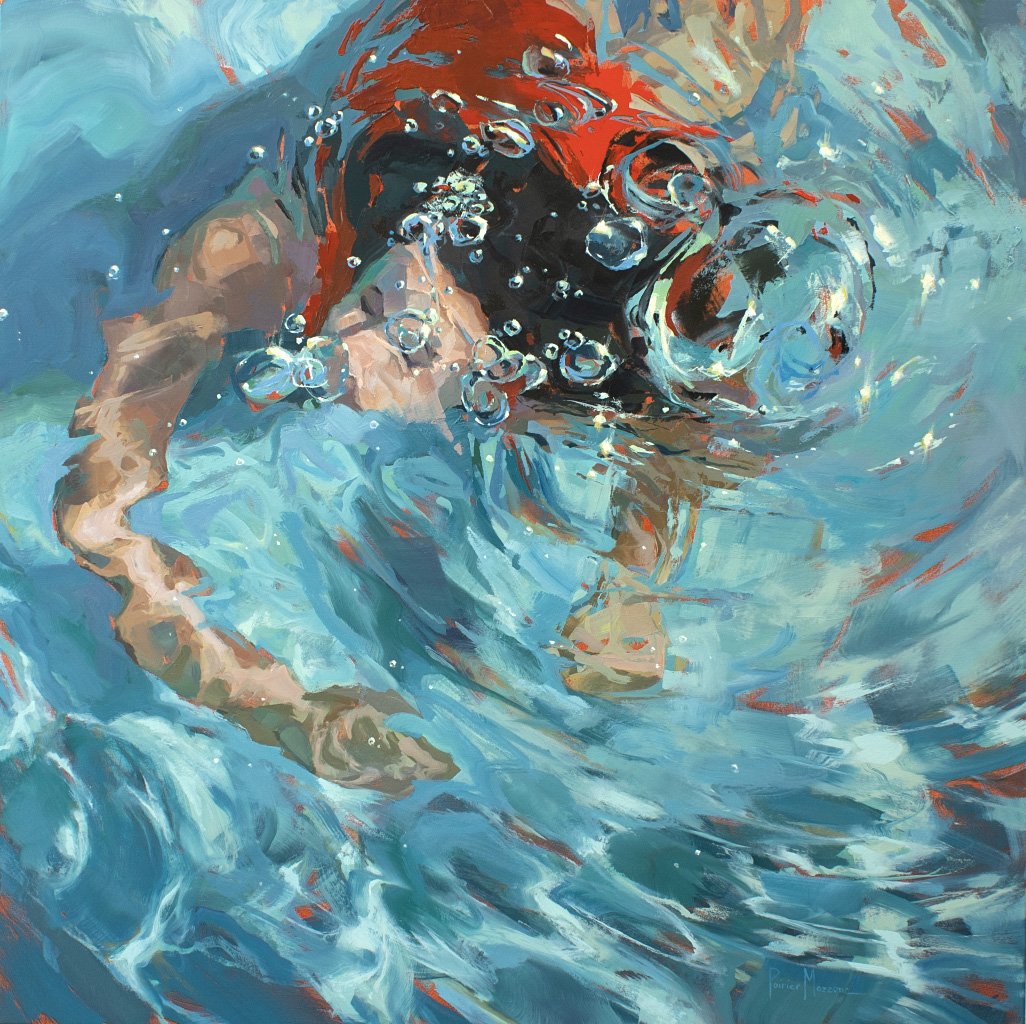
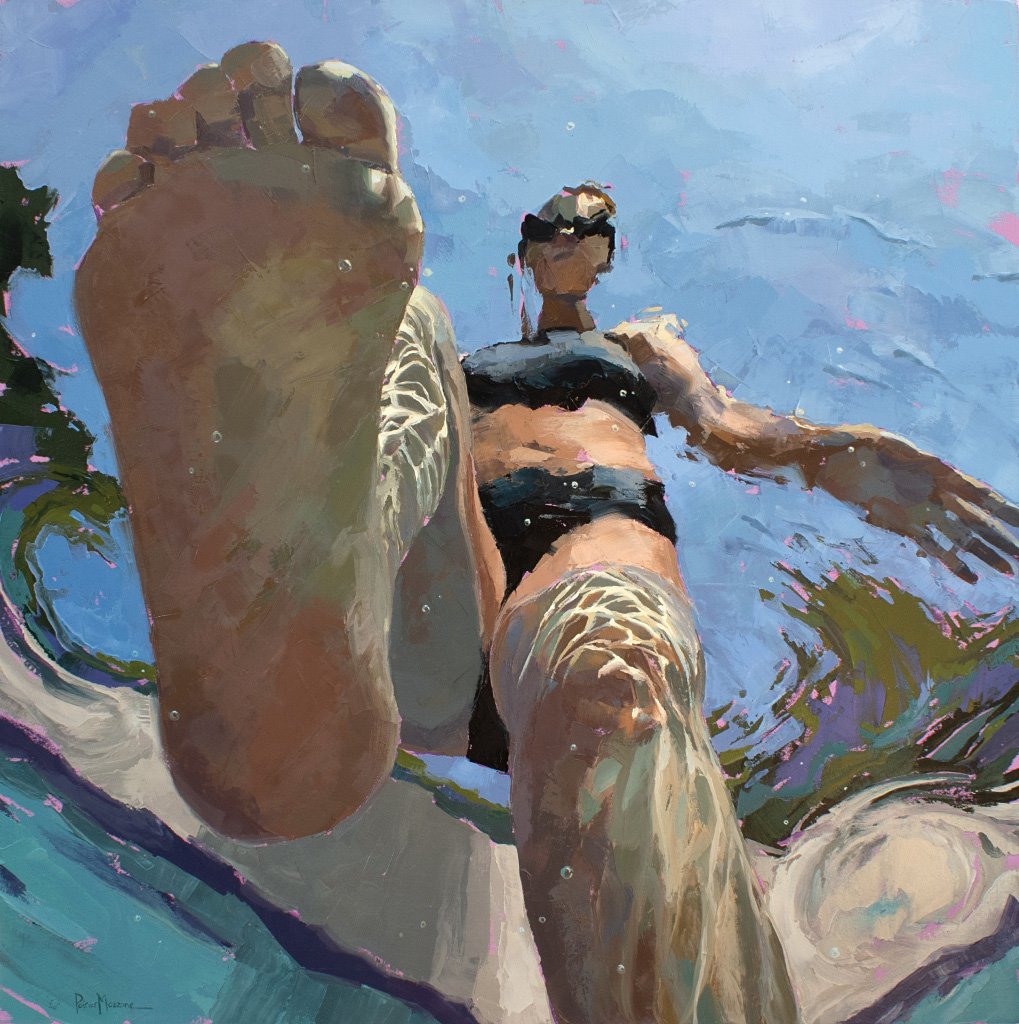
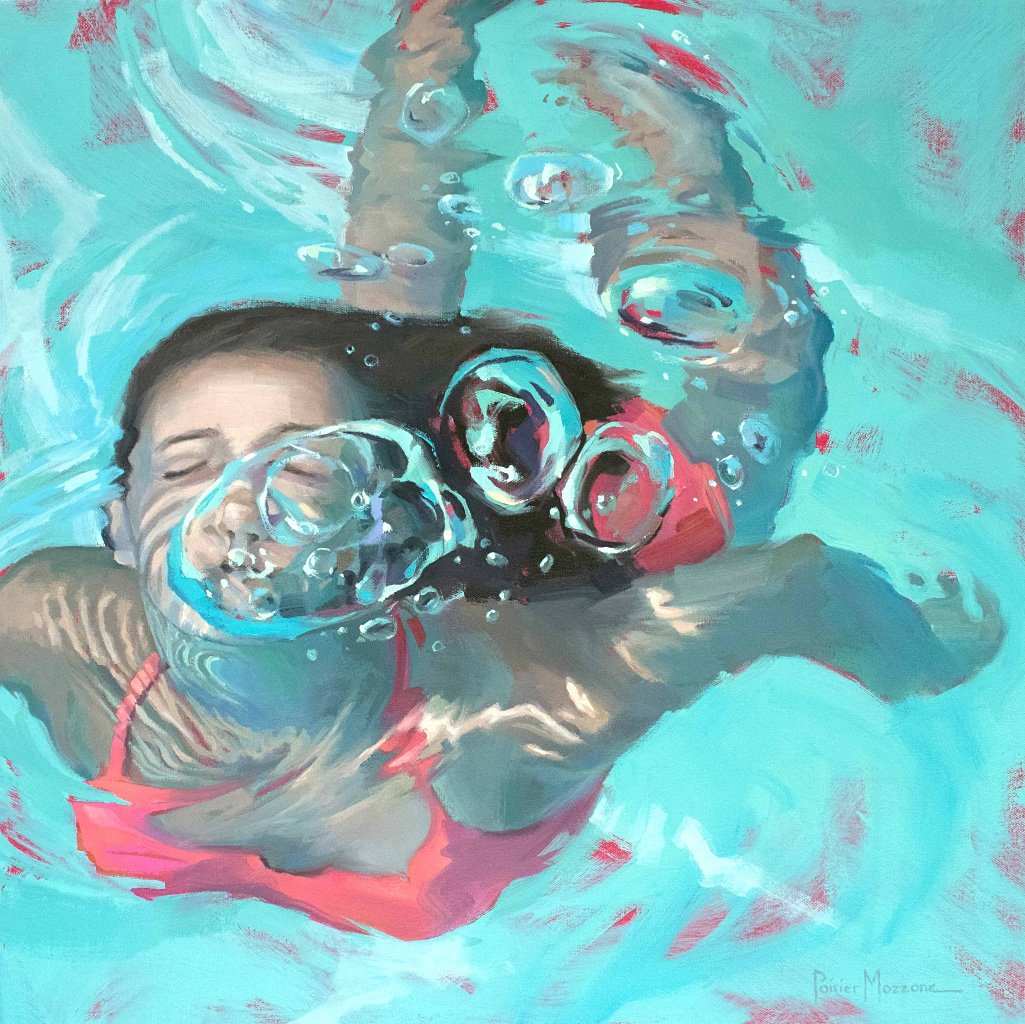

Artistic growth and development are essential for any artist. How have you evolved as a painter over the years, and what challenges have you faced in your artistic journey?
For years after college, I worked in watercolor. I still love the medium for its translucence and inherent beauty. In 2010 I decided to try something different and began to take workshops in pastel. I quickly came to appreciate the medium’s expressiveness and immediacy while developing this series I call “Fractured Light”. Since 2017, I have been translating this body of work into oil paintings. The transition was a difficult one at first. After becoming accustomed to the immediacy of pastel sticks, I found the mixing of colors, cleanup and drying time of oil paint to be cumbersome. I felt my first attempts in oil were not adequately representing this series. Gradually, I began to enjoy the way oil adds texture, to love its richness, depth of color and how it lends itself to large scale work. I also now appreciate oil paint’s slow drying time when working back into areas. Besides subject matter, another focus for me is the application of paint and attempting to say as much as I can with each brushstroke. I try to be open to different directions that present themselves as the painting is in progress and explore varying applications with palette knife and brushes. Painting keeps you humble – despite my best intentions, there is ALWAYS more to learn, ALWAYS room to improve and ALWAYS someone doing it better. That, and seeing evidence of my slow improvement over the years, motivates me keep at it and hopefully the work will mature and evolve.
The “Fractured Light” series emerged from a specific moment at the pool with your daughter. Could you elaborate on the inspiration behind this series and how it has evolved over time?
Although I have painted for most of my life, I began to focus intensely on my art practice in 2010. It was a time of creative rebirth for me. I pushed myself to experiment and shortly after I started using pastel, I decided my creativity needed a “kick in the pants”, so for a few months I painted completely abstract works without any planning – just free-flow abstraction. It was one of the most difficult, frustrating periods for me. Besides a new appreciation for good abstract art, I came away with many mediocre paintings and a feeling that maybe this was a waste of time. I still hadn’t hit upon anything that I felt could lead me into a series of successful paintings. I was in a creative rut.
One exceptionally beautiful afternoon at the pool in 2011, I was struck by the ribbons of sunlight and interesting distortions affecting my daughter through the moving water. I was also keenly aware of catching this lovely, brief moment with her before it flickered by. I grabbed my camera and took numerous photos of her in the water in hopes of using them in a painting. Then it hit me – what if I tried to incorporate an image of the figure in water on to my abstract paintings?
That was the beginning of an exploration that still fascinates me today. I no longer use old abstract paintings as a base, but those early pieces taught me that I am drawn to abstract passages of color and texture alongside gestural representation. I enjoy intuitively exploring patterns, mark-making and the interplay of colors, but I also love painting the figure.
What role does color play in your work? How do you approach color selection and how do you believe it impacts the overall mood or meaning of your paintings?
After composition, color is the most important consideration when I am beginning a painting. Color is like a drug – it is a balance between temperance and indulgence. I love color and some might say I use too much saturation, but I am mindful of tempering the strong colors in my paintings with muted ones to allow the eye to rest. I paint with a limited palette, meaning 4 to 6 colors, plus black and white, which helps unify the painting. I switch up my paint colors when I begin a new painting, often doing a color study to see if my selections will achieve the desired effect. The overall mood of a painting is affected greatly by the palette and value range (lights and darks). More playful pieces have more sunlight and bright color. A somber, reflective piece may have darker water, diffused light and subdued colors.
Can you talk about the relationship between your art and the viewer? What kind of response or connection do you hope to evoke from those who experience your paintings?
I am grateful that this subject matter, which I have been exploring for the past 12 years, also resonates with many people. It has been very gratifying to get feedback from someone who sees themself as a child and relives happy summer memories through my work. Others have expressed their love of the water, their passion for swimming or that a likeness of their children has drawn them to my paintings. It has fed my soul to get this feedback and it probably has kept me on this series when I might have otherwise drifted to something else. But I really do not set out to evoke a particular response. I am expressing something in me that is then interpreted by each viewer in a unique way. I keep my titles short and rather vague so that others can place themselves within the context. I love when one of my pieces evokes a viewpoint or comment from someone that I had never considered.
Words / Amelia Davidson


